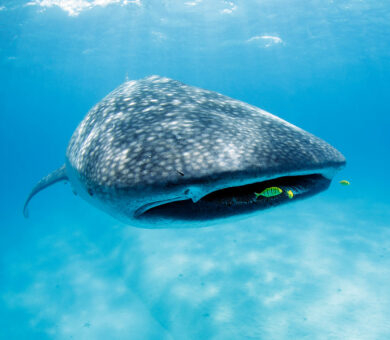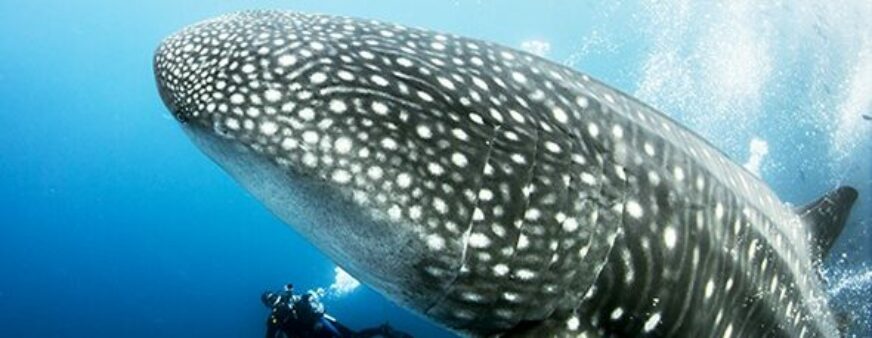Whale Sharks (Rhincodon Typus), are the largest fish species on Earth, reaching lengths of up to 40 feet (12 metres) and weighing as much as 20 tonnes. This breed of shark has a unique patterning of pale-yellow spots against a dark background with wide, flattened heads and extremely large mouths spanning up to 5 feet (1.5 metres) wide which are equipped with hundreds of tiny, vestigial teeth. Whale sharks are docile, posing no threat to humans and are, in fact, a popular tourism and diving attraction for those wishing to see a shark up close.


Whale sharks are found in tropical and warm-temperate seas around the world, living in both coastal and open ocean environments. While they are most commonly sighted in areas with abundant food sources, such as coral reefs and coastal upwelling zones, they are also known to undertake long-distance migrations.
One of the key drivers of whale shark migration is food availability, needing to migrate to locations where their food sources, primarily small fish, plankton and other microscopic organisms, are more abundant during the colder months, typically preferring water temperatures above 21°C (70°F). For example, along the African coast, whale sharks migrate northward during the cooler winter months, to locations such as The Red Sea, and southward as temperatures rise in the summer, to locations such as Madagascar.

Historically the whale shark migration is found in the coastal waters along Tanzania and Eastern Africa between October and February.
Whilst much remains unknown about their mating habits, it’s believed that whale sharks may also migrate to specific areas for breeding purposes, and whilst female whale sharks are known to carry hundreds of pups, the exact locations of breeding and pupping grounds are still being studied.
Whale shark migration patterns, particularly in African waters, are a subject of ongoing scientific inquiry. However, while they are known to inhabit various regions along the African coast, including the eastern coast encompassing the Mozambique Channel, the Red Sea and the Indian Ocean, their migratory behaviour is complex and not yet fully understood. While some general trends in their movements have been observed, we need to remember that these patterns can vary among individuals and populations, highlighting the need for ongoing research to better understand their movements and behaviours throughout the year.
Tracking whale shark migration has become increasingly feasible due to advancements in technology and collaborative research efforts. One key approach involves satellite tagging, where researchers attach sophisticated electronic tags to individual whale sharks. These tags record data such as location, depth, and water temperature, providing valuable insights into their migratory routes and behaviour. By analysing the data transmitted by these tags, scientists can map out the movements of whale sharks over time, identifying important feeding grounds, breeding areas, and migratory pathways.
Acoustic tracking is another valuable tool used in the study of whale shark migration. Researchers deploy underwater listening devices equipped with hydrophones which can detect the unique acoustic signatures emitted by tagged whale sharks. This allows scientists to monitor their movements in real-time and track their migration patterns with precision.
These techniques help scientists map out critical habitats and migration corridors which are essential for the conservation of whale sharks and other marine species. Conservation efforts aimed at protecting whale sharks and their habitats rely heavily on scientific research and data-driven management strategies. By understanding the seasonal movements of whale sharks, conservationists can implement targeted measures to reduce threats such as habitat degradation, overfishing, and bycatch in fisheries.
Whale sharks’ remarkable energy storage mechanisms help to sustain them during long-distance migrations. Their massive size allows them to store significant reserves of fat and energy-rich compounds, which they can metabolise gradually to fuel their movements and maintain bodily functions during periods of fasting or limited food availability. This ability to store energy is critical for surviving the demanding physical exertion of migration, especially across large stretches of open ocean where food options may be scarce.
Whale sharks also possess highly developed sensory organs, including electroreceptors and mechanoreceptors, allowing them to detect changes in water temperature, pressure, and electromagnetic fields. These sensory adaptations help them to navigate oceanic currents, locate food sources, and identify potential mates or breeding grounds along their migratory routes.

The interactions between whale sharks and humans during their migratory journeys can offer unique insights into their behaviour and ecology. As whale sharks migrate, they encounter various human activities and environments that can influence their movements and behaviours.
One significant aspect of human interaction with migrating whale sharks is through ecotourism. In regions where whale sharks congregate, such as the Mozambique Channel or the coast of Tanzania, ecotourism operators offer opportunities for tourists to swim and snorkel alongside the sharks. These interactions provide invaluable opportunities for researchers and enthusiasts to observe whale sharks in their natural habitat, contributing to our understanding of their social dynamics.
Whale shark migrations often intersect with commercial fishing activities, presenting challenges for both fishermen and conservationists. In some cases, whale sharks may be accidentally caught as bycatch in fishing nets, particularly in areas where they overlap with fisheries targeting other species. Efforts to reduce bycatch through the implementation of whale shark-friendly fishing practices, restricted fishing activities in certain zones and modifications are ongoing, aiming to reduce accidental harm to any migrating sharks.

Along their journeys whale sharks may also encounter marine pollution and habitat degradation caused by humans. Coastal development, pollution from land-based sources and climate change can all affect the quality of their habitat and the availability of food resources along their migration paths. These factors can significantly impact the routes and survival rates of migrating whale sharks, shaping their population dynamics and highlighting the need for conservation strategies to ensure the long-term survival of this species.

In places such as Mafia Island in Tanzania or the Ningaloo Reef in Western Australia, shark migration has become a focal point for tourism, with tourists flocking to these destinations during times of the year when the whale sharks congregate in large numbers. If you’d like more information about our experiences or planning a trip around whale shark migration, get in touch with our expert team today.
